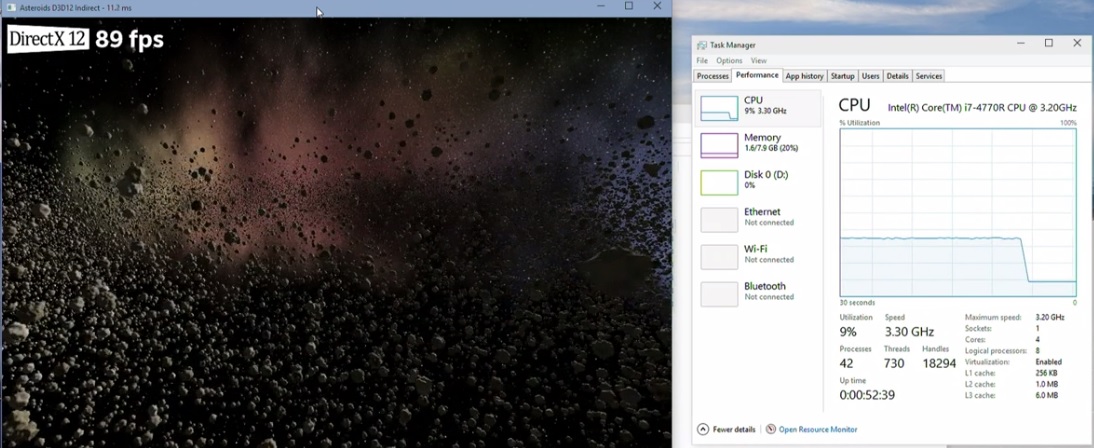Install the app
How to install the app on iOS
Follow along with the video below to see how to install our site as a web app on your home screen.
Note: This feature may not be available in some browsers.
You are using an out of date browser. It may not display this or other websites correctly.
You should upgrade or use an alternative browser.
You should upgrade or use an alternative browser.
DirectX 12: The future of it within the console gaming space (specifically the XB1)
- Thread starter Shortbread
- Start date
Ahh but it's build on UE4, 20% across such a popular engine is not to be sniffed at.Of all the games to potentially have a 20% rendering performance increase in, Fable Legends is right at the bottom of my 'Give a shit' list.
It might be per title however. I think controlling how UAV works is based upon how you want it to work.Ahh but it's build on UE4, 20% across such a popular engine is not to be sniffed at.
FarticusMaximus
Newcomer
Ahh but it's build on UE4, 20% across such a popular engine is not to be sniffed at.
Good point, and obviously any optimisation gains are welcome as any DX12 techniques and engine enhancements learned will likely be shared amongst studios.
This is a nice iterative improvement over the OpenGL 4.4/4.5 multi-draw indirect.
You don't need to ask me how happy I have been about getting this feature finally to DirectX
Last edited:
liquidboy
Regular
ashes of the singularity https://twitter.com/draginol/status/573316247166705664What about the unbelievable dx12 tech demo that was a game that was a tech demo?
Andrew: Do you know whether the modified Intel asteroids demo (with ExecuteIndirect) shown by Max in his presentation was running on Intel (Broadwell) GPU? If so, then I must thank you for very nice ExecuteIndirect performance. It was good to see some (10%+) GPU gains as well (the huge CPU gains were obviously expected).
Andrew: Do you know whether the modified Intel asteroids demo (with ExecuteIndirect) shown by Max in his presentation was running on Intel (Broadwell) GPU? If so, then I must thank you for very nice ExecuteIndirect performance. It was good to see some (10%+) GPU gains as well (the huge CPU gains were obviously expected).
Core i7-4770R :

http://www.dsogaming.com/news/direc...proves-performance-greatly-reduces-cpu-usage/
It is the Haswell flagship GPU. Broadwell eDRAM versions have not yet been announced.Core i7-4770R
Intel® Iris™ Pro Graphics 5200
Graphics Base Frequency: 200 MHz
Graphics Max Dynamic Frequency: 1.3 GHz
It would be interesting to see the GPU clock rate. It might be that the greatly reduced CPU utilization allows the GPU to run at slightly higher clock speed when ExecuteIndirect is used. It is great to see that bindless makes Intel GPUs faster as well and ExecuteIndirect (/MDI) is also beneficial on Intel GPUs. We already know from the OpenGL 4.4 benchmarks that MDI is the fastest way to push draw calls on NVIDIA and AMD GPUs (assuming you don't need to change state/bindings/shaders).
ExecuteIndirect adds support for binding changes, so it is applicable on more situations than MDI. What we are still lacking, is support for state and shader changes. NVIDIA has a new custom extension that allows limited state changes by the GPU between the draws. The future seems clear. Soon the GPU can do all the necessary steps to render complex scenes by itself.
Another great thing Max mentioned in his DX12 presentation is predicated rendering. The GPU can finally read predicates from GPU buffers, meaning that GPU can instruct itself to skip over sections of the command buffer based on compute shader calculation results. This means that we have basically a simple form of command buffer branches. ExecuteIndirect implements a simple form of command buffer loops. If ExecuteIndirect gets expanded in the future to allow looping arbitrary command buffers, we are very close to the goal of fully programmable command processor already. I need to start writing a DX13 wish list already. Hopefully the hardware vendors are listening
Last edited:
Nooo... we do not need any more waiting on the internet. LOL
 It will buckle under the pressure!
It will buckle under the pressure!DmitryKo
Veteran
Should have been named "Improvements to CPU/GPU efficiency in DirectX 12"
- Parallel execution engines - 11:30-18:00
- GPU efficiency (queries, predication, execute indirect) - 18:00-25:30
- CPU overhead (resource binding, multithreading) - 26:05-36:15
ashes of the singularity https://twitter.com/draginol/status/573316247166705664
- Ashes of the Singularity demo - 36:15 - 45:15
Dan Baker, Graphics Architect, Oxide Games
Similar threads
- Replies
- 14
- Views
- 4K
- Replies
- 4
- Views
- 2K
- Replies
- 3
- Views
- 13K
- Replies
- 200
- Views
- 39K
- Replies
- 92
- Views
- 14K
























